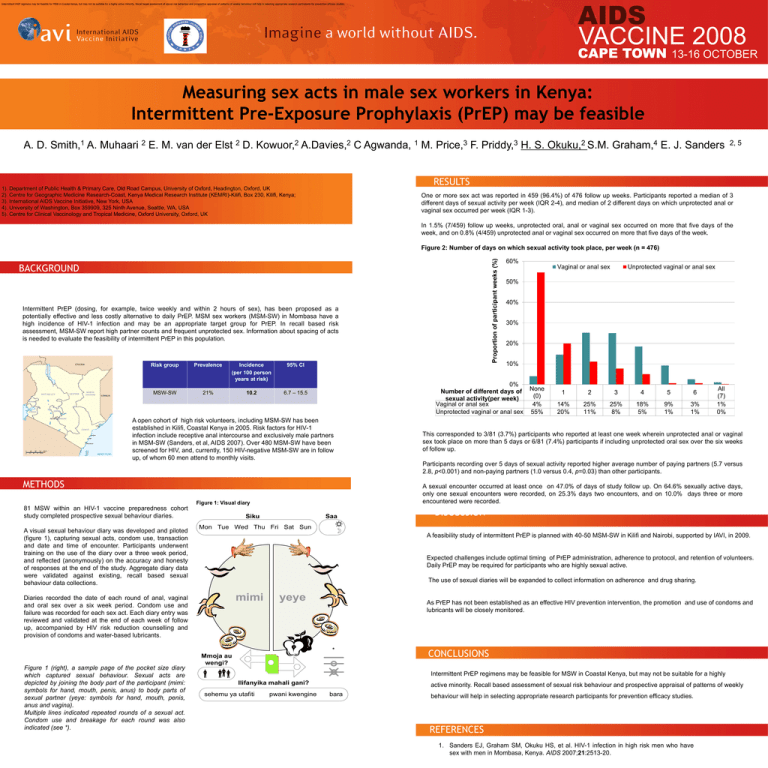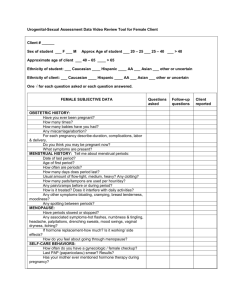
Intermittent PrEP regimens may be feasible for MSW in Coastal Kenya, but may not be suitable for a highly active minority. Recall based assessment of sexual risk behaviour and prospective appraisal of patterns of weekly behaviour will help in selecting appropriate research participants for prevention efficacy studies.
Measuring sex acts in male sex workers in Kenya:
Intermittent Pre-Exposure Prophylaxis (PrEP) may be feasible
A. D.
1
Smith,
2
2
A. Muhaari E. M. van der Elst D.
2
Kowuor,
2
A.Davies,
1
C Agwanda, M.
3
Price,
F.
3
Priddy,
H. S.
2
Okuku, S.M.
4
Graham,
E. J. Sanders
2, 5
RESULTS
1). Department of Public Health & Primary Care, Old Road Campus, University of Oxford, Headington, Oxford, UK
2). Centre for Geographic Medicine Research-Coast, Kenya Medical Research Institute (KEMRI)-Kilifi, Box 230, Kilifi, Kenya;
3). International AIDS Vaccine Initiative, New York, USA
4). University of Washington, Box 359909, 325 Ninth Avenue, Seattle, WA, USA
5). Centre for Clinical Vaccinology and Tropical Medicine, Oxford University, Oxford, UK
One or more sex act was reported in 459 (96.4%) of 476 follow up weeks. Participants reported a median of 3
different days of sexual activity per week (IQR 2-4), and median of 2 different days on which unprotected anal or
vaginal sex occurred per week (IQR 1-3).
In 1.5% (7/459) follow up weeks, unprotected oral, anal or vaginal sex occurred on more that five days of the
week, and on 0.8% (4/459) unprotected anal or vaginal sex occurred on more that five days of the week.
Proportion of participant weeks (%)
Figure 2: Number of days on which sexual activity took place, per week (n = 476)
BACKGROUND
Intermittent PrEP (dosing, for example, twice weekly and within 2 hours of sex), has been proposed as a
potentially effective and less costly alternative to daily PrEP. MSM sex workers (MSM-SW) in Mombasa have a
high incidence of HIV-1 infection and may be an appropriate target group for PrEP. In recall based risk
assessment, MSM-SW report high partner counts and frequent unprotected sex. Information about spacing of acts
is needed to evaluate the feasibility of intermittent PrEP in this population.
Risk group
MSW-SW
Prevalence
Incidence
(per 100 person
years at risk)
21%
10.2
95% CI
60%
A open cohort of high risk volunteers, including MSM-SW has been
established in Kilifi, Coastal Kenya in 2005. Risk factors for HIV-1
infection include receptive anal intercourse and exclusively male partners
in MSM-SW (Sanders, et al, AIDS 2007). Over 480 MSM-SW have been
screened for HIV, and, currently, 150 HIV-negative MSM-SW are in follow
up, of whom 60 men attend to monthly visits.
Unprotected vaginal or anal sex
50%
40%
30%
20%
10%
0%
Number of different days of
sexual activity(per week)
Vaginal or anal sex
Unprotected vaginal or anal sex
6.7 – 15.5
Vaginal or anal sex
None
(0)
4%
55%
1
2
3
4
5
6
14%
20%
25%
11%
25%
8%
18%
5%
9%
1%
3%
1%
All
(7)
1%
0%
This corresponded to 3/81 (3.7%) participants who reported at least one week wherein unprotected anal or vaginal
sex took place on more than 5 days or 6/81 (7.4%) participants if including unprotected oral sex over the six weeks
of follow up.
Participants recording over 5 days of sexual activity reported higher average number of paying partners (5.7 versus
2.8, p<0.001) and non-paying partners (1.0 versus 0.4, p=0.03) than other participants.
METHODS
A sexual encounter occurred at least once on 47.0% of days of study follow up. On 64.6% sexually active days,
only one sexual encounters were recorded, on 25.3% days two encounters, and on 10.0% days three or more
encountered were recorded.
Figure 1: Visual diary
81 MSW within an HIV-1 vaccine preparedness cohort
study completed prospective sexual behaviour diaries.
A visual sexual behaviour diary was developed and piloted
(figure 1), capturing sexual acts, condom use, transaction
and date and time of encounter. Participants underwent
training on the use of the diary over a three week period,
and reflected (anonymously) on the accuracy and honesty
of responses at the end of the study. Aggregate diary data
were validated against existing, recall based sexual
behaviour data collections.
Siku
Saa
Mon Tue Wed Thu Fri Sat Sun
A feasibility study of intermittent PrEP is planned with 40-50 MSM-SW in Kilifi and Nairobi, supported by IAVI, in 2009.
Expected challenges include optimal timing of PrEP administration, adherence to protocol, and retention of volunteers.
Daily PrEP may be required for participants who are highly sexual active.
The use of sexual diaries will be expanded to collect information on adherence and drug sharing.
mimi
Diaries recorded the date of each round of anal, vaginal
and oral sex over a six week period. Condom use and
failure was recorded for each sex act. Each diary entry was
reviewed and validated at the end of each week of follow
up, accompanied by HIV risk reduction counselling and
provision of condoms and water-based lubricants.
yeye
As PrEP has not been established as an effective HIV prevention intervention, the promotion and use of condoms and
lubricants will be closely monitored.
*
Figure 1 (right), a sample page of the pocket size diary
which captured sexual behaviour. Sexual acts are
depicted by joining the body part of the participant (mimi:
symbols for hand, mouth, penis, anus) to body parts of
sexual partner (yeye: symbols for hand, mouth, penis,
anus and vagina).
Multiple lines indicated repeated rounds of a sexual act.
Condom use and breakage for each round was also
indicated (see *).
REFERENCES
DISCUSSION
Mmoja au
wengi?
CONCLUSIONS
Intermittent PrEP regimens may be feasible for MSW in Coastal Kenya, but may not be suitable for a highly
Ilifanyika mahali gani?
sehemu ya utafiti
pwani kwengine
active minority. Recall based assessment of sexual risk behaviour and prospective appraisal of patterns of weekly
bara
behaviour will help in selecting appropriate research participants for prevention efficacy studies.
REFERENCES
1. Sanders EJ, Graham SM, Okuku HS, et al. HIV-1 infection in high risk men who have
sex with men in Mombasa, Kenya. AIDS 2007;21:2513-20.





